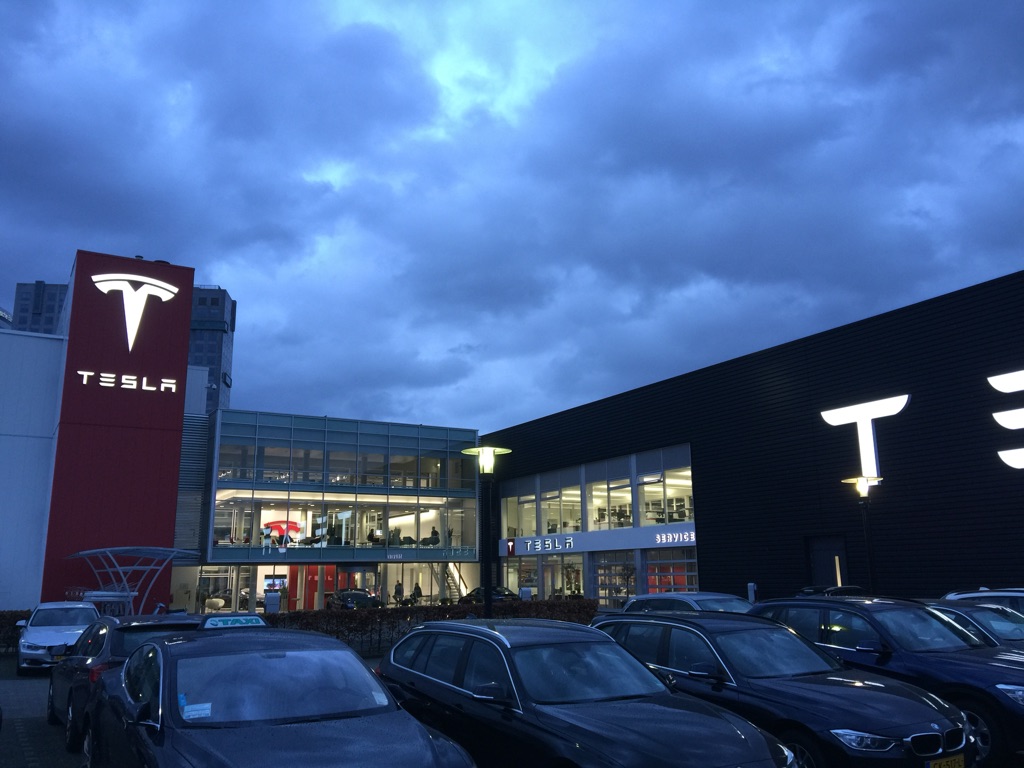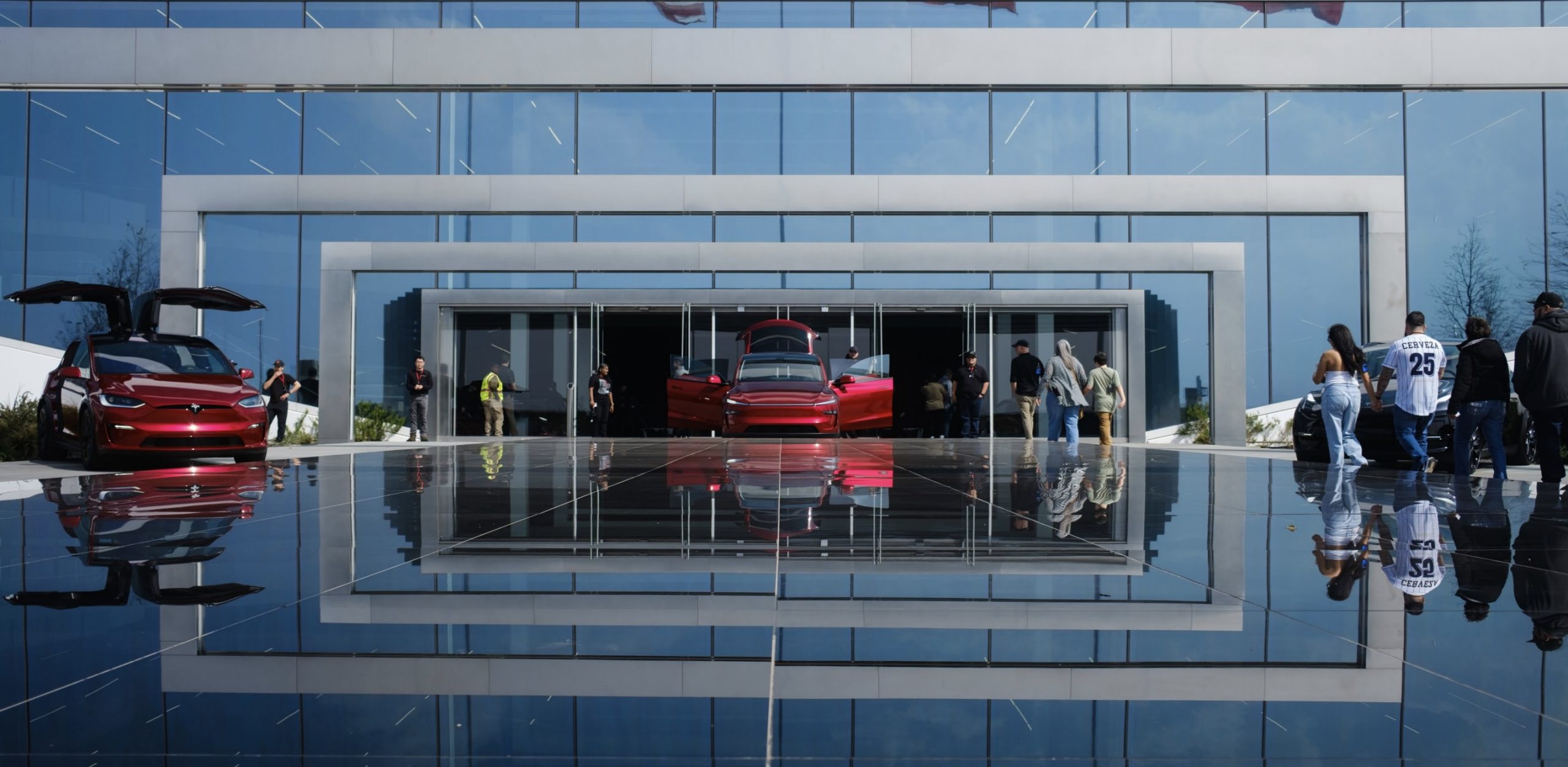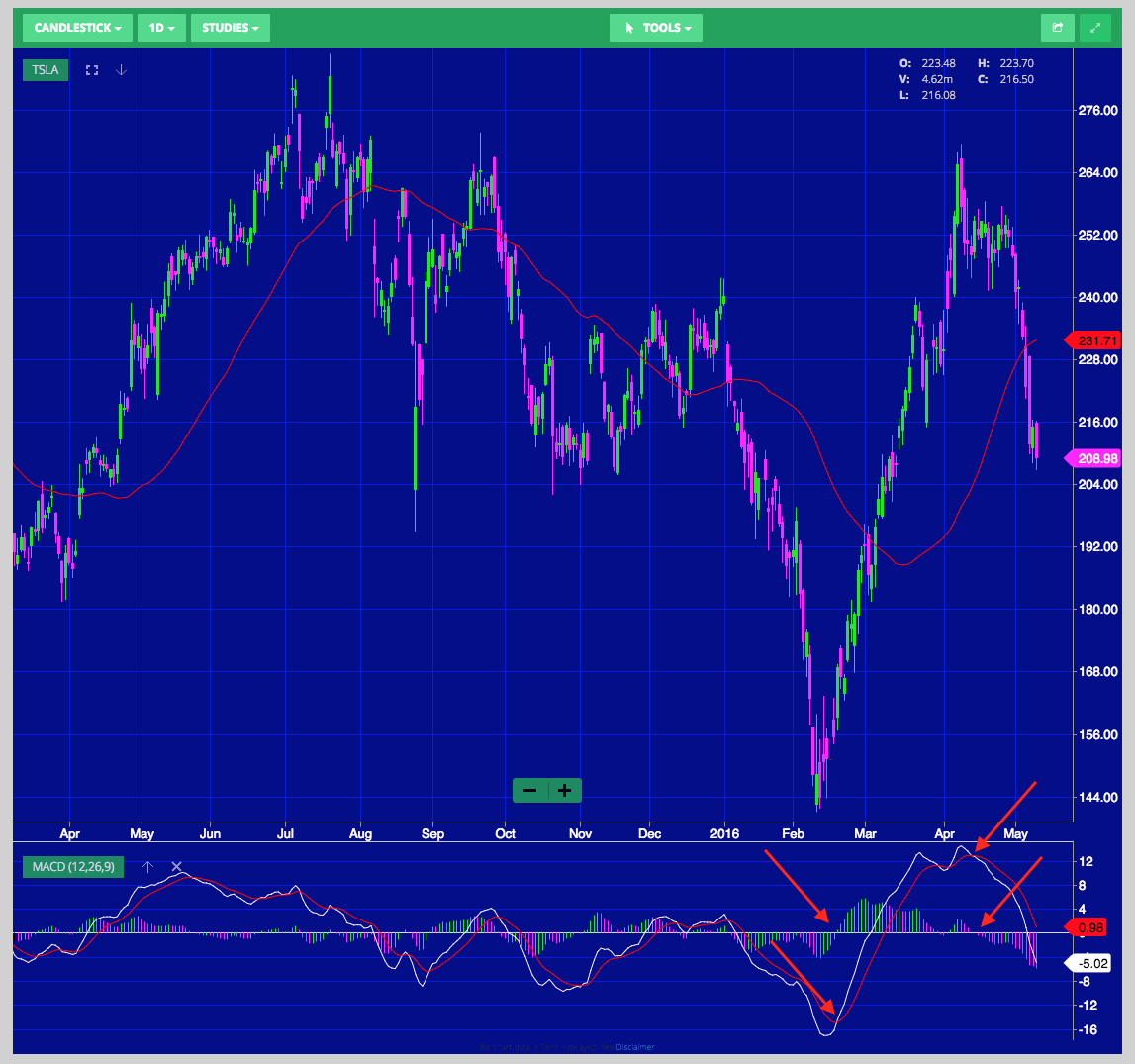Investor's Corner
Tesla stock (TSLA) one week after the Q1 2016 Report

Post Q1 Report Action
The technical response of the stock market to last week’s Tesla Q1 2016 report has been mostly negative. The stock lost quite a bit since last week, standing at around $208 when I write this, but overall 12-month Analyst Price Targets have actually increased with the average raising from $253 to $277, indicating that the Top Analysts did not see the report as negatively as this past week’s market action.
This is a small sample of the reactions from Top Analysts, noting that none of them changed their position to BUY, SELL or HOLD.
Adam Jonas of Morgan Stanley, reiterated a BUY with $333 price target, commenting that “we forecast ~70k units in 2016 (vs. the reiterated guidance of 80-90k shipments), which is composed of ~16k Model X and ~54k Model S units. In 2Q, we forecast ~17k deliveries–inline with the outlook.”
Charlie Anderson of Dougherty resumed coverage of TSLA with a BUY and price target of $500, noting that “the focus coming out of the Q1 report is on managements decision to pull-forward its production goal of 500K vehicles from 2020 to 2018. While this aggressive schedule certainly increases the risk of nearer-term stumbles, it also significantly pulls forward the earnings power. Tesla has set a goal to produce 1MM vehicles by 2020, roughly 2x what most observers previously believed. Our view is that demand is not the question; it is solving the manufacturing challenges deftly as they come.”
Brian Johnson of Barclays reiterated a SELL with $165 price target.
Ryan Brinkman of J.P. Morgan reiterated a SELL with $185 price target, as he “Doubts Tesla Motors Can Meet Accelerated Production Target.”
Colin Rusch or Oppenheimer reiterated a BUY with $385 price target, indicating that “we believe the critical characteristic of TSLAs business model over the next 24 months will be operating leverage. We believe the company can achieve 15%+ incremental operating margins as it ramps the Model 3. We modeling TSLA reaching 500k vehicles in 2019 vs. the target of 2018, noting the company has a history of setting nearly unachievable goals. Effectively we are accelerating ramp by a year from our previous expectations, but calculate that if the company reaches its 500k vehicle target in 2018 and 1M in 2020, our EPS estimates will prove ~30% too low.”
See the table below from TipRanks (tipranks.com) for a complete summary of the current top analyst ratings.
Swing Trading TSLA using the MACD
This is the first post where I will start outlining techniques that traders may want to use when trading TSLA stock.
I am mostly a “swing trader”. Swing Trading is a short term trading method that can be used when trading stocks and options. Whereas Day Trading positions last less than one day, Swing Trading positions typically last two to six days, but may last as long as two weeks (for TSLA sometime six-seven weeks). Swing traders use technical analysis to look for stocks with short-term price momentum. These traders aren’t interested in the fundamental or intrinsic value of stocks, but rather in their price trends and patterns.
There are a number of technical indicators that swing traders use. Today I will cover the MACD. The Moving Average Convergence Divergence (MACD) is a trend-following momentum indicator that shows the relationship between two moving averages of prices. The MACD is calculated by subtracting the 26-day exponential moving average (EMA) from the 12-day EMA. The Exponential Moving Average (EMA) is a type of moving average that is similar to a simple moving average, except that more weight is given to the latest data.
The good thing is that you really do not have to calculate any of these indicators yourself, as pretty much all trading platforms that I know of provide you with such indicators as an option when displaying the stock chart of a given security.
The following stock chart from Wall Street I/O shows the TSLA market data as “candlestick” (showing open, close, high and low of the day) for the past year, plus it also shows the MACD for the same period.
One technique that swing traders use is to enter a “long” trade when the MACD “crosses to the bulls”, and exit the trade when the MACD “crosses to the bears”. I have indicated these points in the chart for the huge run up between the February low and April high.
Micah Lamar is the CEO of Wall Street I/O (wallst.io), where together with his team of experts he helps people learn stock and option trading. Disclosure: I have been a subscriber to wallst.io for a few years.
This past weekend, Micah run a “MACD Validation” experiment on TSLA 1-year behavior up to last Friday close. The results are as follows.
Micah found that “if one had bought TSLA stock exactly a year ago, and held it for the full year, one would have incurred a $30 loss per share.
If one had bought and held TSLA stock while the MACD was bullish, one would be up $22 for the year.
If one had sold (short) TSLA stock while the MACD was bearish, one would be up $51 for the year.”
Someone trading both sides (long and short the stock) would be up a whopping $73, or a $30% gain.
Of course, trading the same entry and exit points based on the MACD with put or call options instead of stock would have resulted in returns 10 to 100 times or better than if just trading TSLA stock.
Micah indicates that “TSLA is a great stock for swing traders: the reason is that it has so much “beta.” A high beta indicates that a security is much more “volatile” than the rest of the market. Most high-tech stocks like TSLA have a beta of greater than 1, offering the possibility of a higher rate of return, but also posing more risk.
As far as where TSLA is today, it is still in “bearish” territory (as far as the MACD and other indicators are concerned), which for me it means that it is untouchable on long trades as “too risky”, and since I do not like to play on the downside for stocks of companies that are in my “buy what you know” list, I will not trade it again until the MACD crosses back to the bulls.

Investor's Corner
Tesla Q4 delivery numbers are better than they initially look: analyst
The Deepwater Asset Management Managing Partner shared his thoughts in a post on his website.

Longtime Tesla analyst and Deepwater Asset Management Managing Partner Gene Munster has shared his insights on Tesla’s Q4 2025 deliveries. As per the analyst, Tesla’s numbers are actually better than they first appear.
Munster shared his thoughts in a post on his website.
Normalized December Deliveries
Munster noted that Tesla delivered 418k vehicles in the fourth quarter of 2025, slightly below Street expectations of 420k but above the whisper number of 415k. Tesla’s reported 16% year-over-year decline, compared to +7% in September, is largely distorted by the timing of the tax credit expiration, which pulled forward demand.
“Taking a step back, we believe September deliveries pulled forward approximately 55k units that would have otherwise occurred in December or March. For simplicity, we assume the entire pull-forward impacted the December quarter. Under this assumption, September growth would have been down ~5% absent the 55k pull-forward, a Deepwater estimate tied to the credit’s expiration.
“For December deliveries to have declined ~5% year over year would imply total deliveries of roughly 470k. Subtracting the 55k units pulled into September results in an implied December delivery figure of approximately 415k. The reported 418k suggests that, when normalizing for the tax credit timing, quarter-over-quarter growth has been consistently down ~5%. Importantly, this ~5% decline represents an improvement from the ~13% declines seen in both the March and June 2025 quarters.“
Tesla’s United States market share
Munster also estimated that Q4 as a whole might very well show a notable improvement in Tesla’s market share in the United States.
“Over the past couple of years, based on data from Cox Automotive, Tesla has been losing U.S. EV market share, declining to just under 50%. Based on data for October and November, Cox estimates that total U.S. EV sales were down approximately 35%, compared to Tesla’s just reported down 16% for the full quarter. For the first two months of the quarter, Cox reported Tesla market share of roughly a 65% share, up from under 50% in the September quarter.
“While this data excludes December, the quarter as a whole is likely to show a material improvement in Tesla’s U.S. EV market share.“
Elon Musk
Tesla analyst breaks down delivery report: ‘A step in the right direction’
“This will be viewed as better than feared deliveries and a step in the right direction for the Tesla story heading into 2026,” Ives wrote.

Tesla analyst Dan Ives of Wedbush released a new note on Friday morning just after the company released production and delivery figures for Q4 and the full year of 2025, stating that the numbers, while slightly underwhelming, are “better than feared” and as “a step in the right direction.”
Tesla reported production of 434,358 and deliveries of 418,227 for the fourth quarter, while 1,654,667 vehicles were produced and 1,636,129 cars were delivered for the full year.
Tesla releases Q4 and FY 2025 vehicle delivery and production report
Interestingly, the company posted its own consensus figures that were compiled from various firms on its website a few days ago, where expectations were set at 1,640,752 cars for the year. Tesla fell about 4,000 units short of that. One of the areas where Tesla excelled was energy deployments, which totaled 46.7 GWh for the year.
🚨 Wedbush’s Dan Ives has released a new note on Tesla $TSLA:
“Tesla announced its FY4Q25 delivery numbers this morning coming in at 418.2k vehicles slightly below the company’s consensus delivery estimate of 422.9k but much better than the whisper numbers of ~410k as the…
— TESLARATI (@Teslarati) January 2, 2026
In terms of vehicle deliveries, Ives writes that Tesla certainly has some things to work through if it wants to return to growth in that aspect, especially with the loss of the $7,500 tax credit in the U.S. and “continuous headwinds” for the company in Europe.
However, Ives also believes that, given the delivery numbers, which were on par with expectations, Tesla is positioned well for a strong 2026, especially with its AI focus, Robotaxi and Cybercab development, and energy:
“This will be viewed as better than feared deliveries and a step in the right direction for the Tesla story heading into 2026. We look forward to hearing more at the company’s 4Q25 call on January 28th. AI Valuation – The Focus Throughout 2026. We believe Tesla could reach a $2 trillion market cap over the coming year and, in a bull case scenario, $3 trillion by the end of 2026…as full-scale volume production begins with the autonomous and robotics roadmap…The company has started to test the all-important Cybercab in Austin over the past few weeks, which is an incremental step towards launching in 2026 with important volume production of Cybercabs starting in April/May, which remains the golden goose in unlocking TSLA’s AI valuation.”
It’s no secret that for the past several years, Tesla’s vehicle delivery numbers have been the main focus of investors and analysts have looked at them as an indicator of company health to a certain extent. The problem with that narrative in 2025 and 2026 is that Tesla is now focusing more on the deployment of Full Self-Driving, its Optimus project, AI development, and Cybercab.
While vehicle deliveries still hold importance, it is more crucial to note that Tesla’s overall environment as a business relies on much more than just how many cars are purchased. That metric, to a certain extent, is fading in importance in the grand scheme of things, but it will never totally disappear.
Ives and Wedbush maintained their $600 price target and an ‘Outperform’ rating on the stock.
Investor's Corner
Tesla releases Q4 and FY 2025 vehicle delivery and production report
Deliveries stood at 406,585 Model 3/Y and 11,642 other models, for a total of 418,227 vehicles.

Tesla (NASDAQ:TSLA) has reported its Q4 2025 production and deliveries, with 418,227 vehicles delivered and 434,358 produced worldwide. Energy storage deployments hit a quarterly record at 14.2 GWh.
Tesla’s Q4 and FY 2025 results were posted on Friday, January 2, 2026.
Q4 2025 production and deliveries
In Q4 2025, Tesla produced 422,652 Model 3/Y units and 11,706 other models, which are comprised of the Model S, Model X, and the Cybertruck, for a total of 434,358 vehicles. Deliveries stood at 406,585 Model 3/Y and 11,642 other models, for a total of 418,227 vehicles.
Energy deployments reached 14.2 GWh, a new record. Similar to other reports, Tesla posted a company thanked customers, employees, suppliers, shareholders, and supporters for its fourth quarter results.
In comparison, analysts included in Tesla’s company-compiled consensus estimate that Tesla would deliver 422,850 vehicles and deploy 13.4 GWh of battery storage systems in Q4 2025.
Tesla’s Full Year 2025 results
For the full year, Tesla produced a total of 1,654,667 vehicles, comprised of 1,600,767 Model Y/3 and 53,900 other models. Tesla also delivered 1,636,129 vehicles in FY 2025, comprised of 1,585,279 Model Y/3 and 50,850 other models. Energy deployments totaled 46.7 GWh over the year.
In comparison, analysts included in Tesla’s company-compiled consensus expected the company to deliver a total of 1,640,752 vehicles for full year 2025. Analysts also expected Tesla’s energy division to deploy a total of 45.9 GWh during the year.
Tesla will post its financial results for the fourth quarter of 2025 after market close on Wednesday, January 28, 2026. The company’s Q4 and FY 2025 earnings call is expected to be held on the same day at 4:30 p.m. Central Time.
![TSLA analyst coverage [Source: TipRanks] TSLA analyst coverage [Source: TipRanks]](http://www.teslarati.com/wp-content/uploads/2016/05/TipRanks-1.png)









